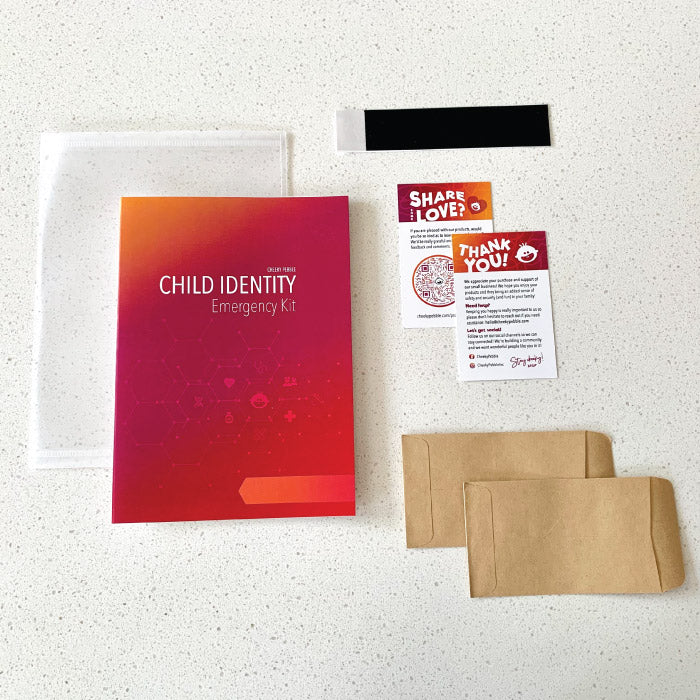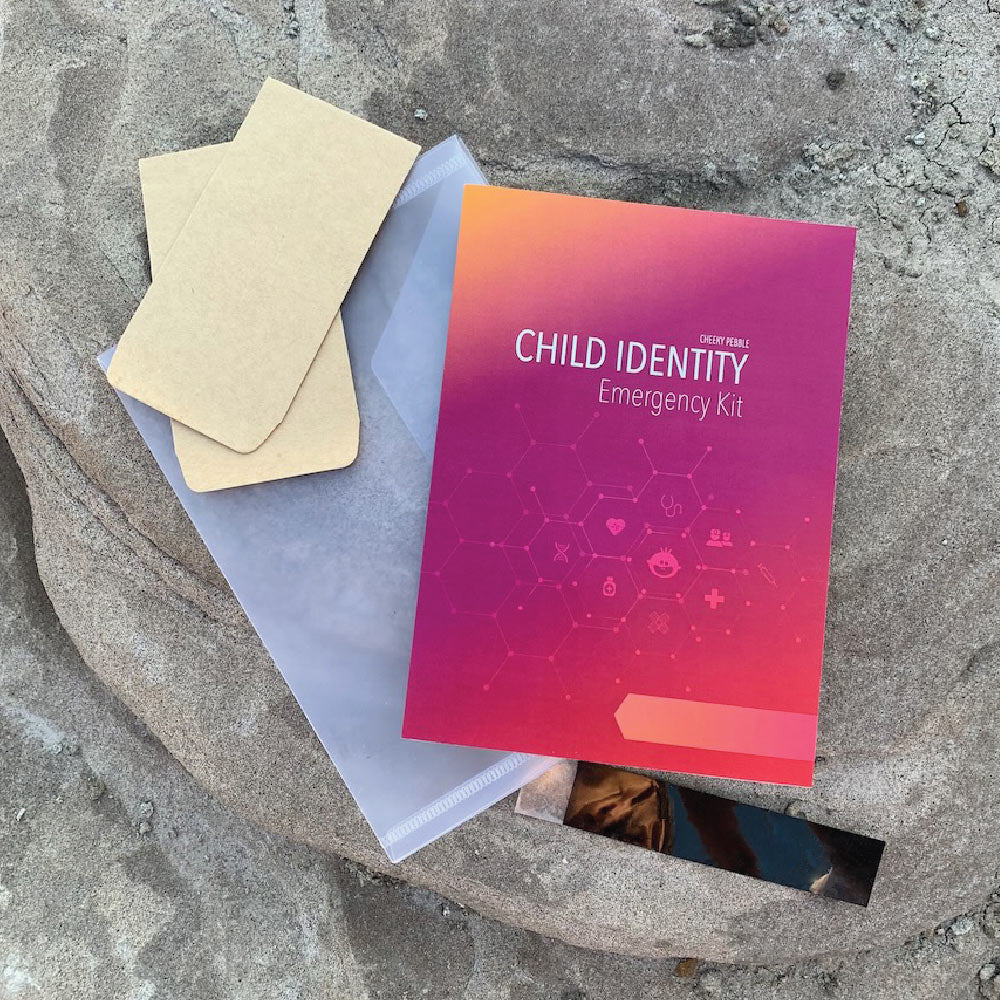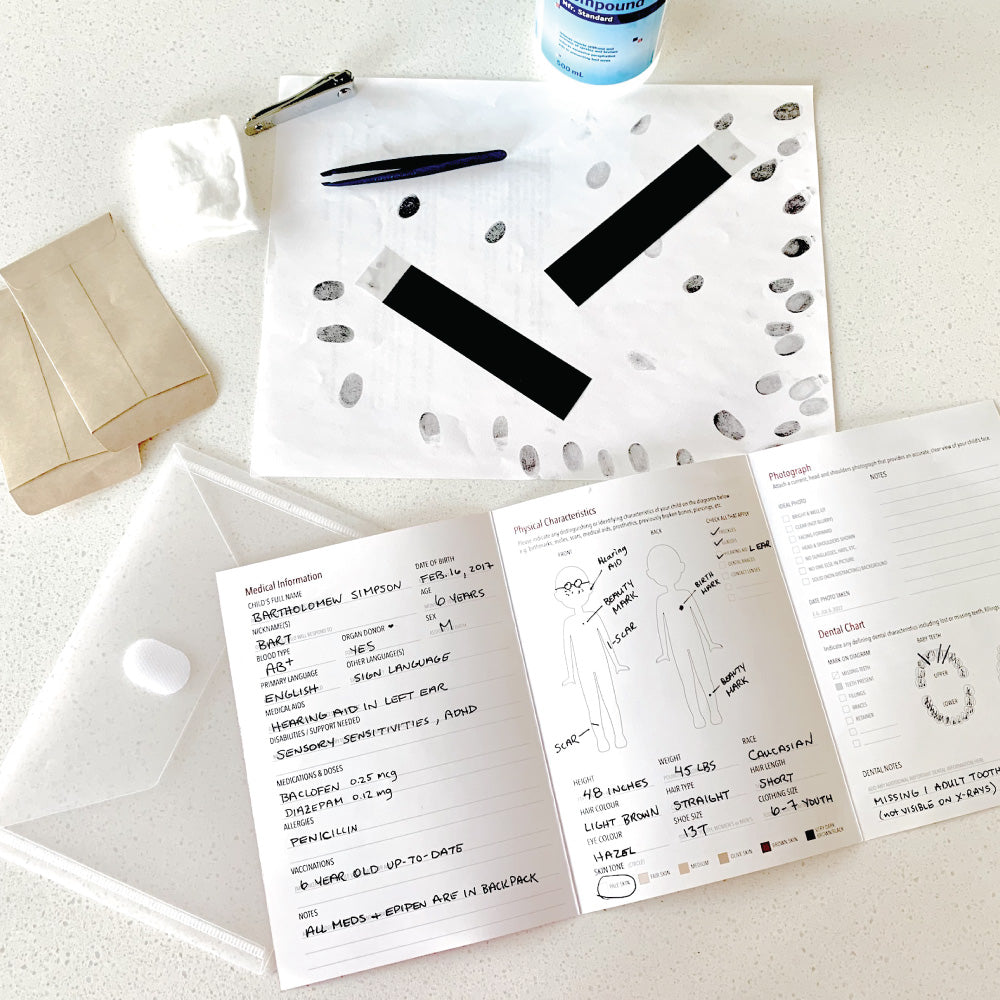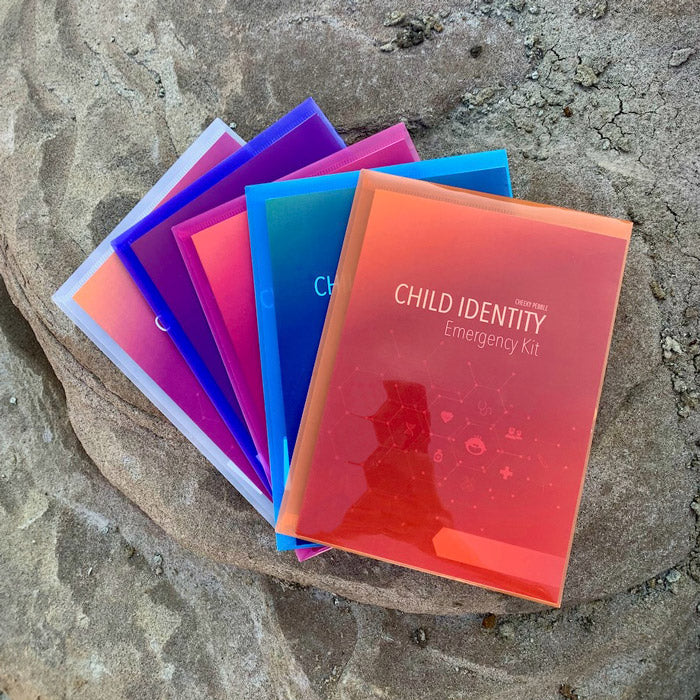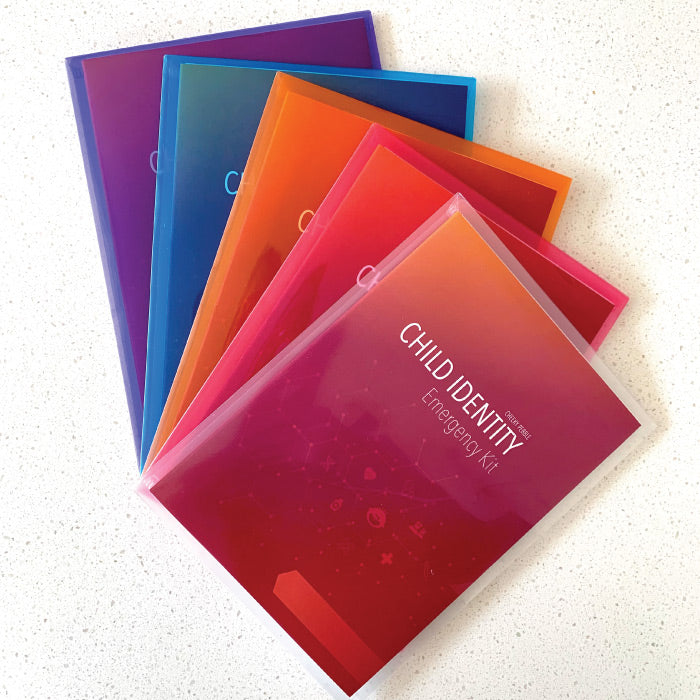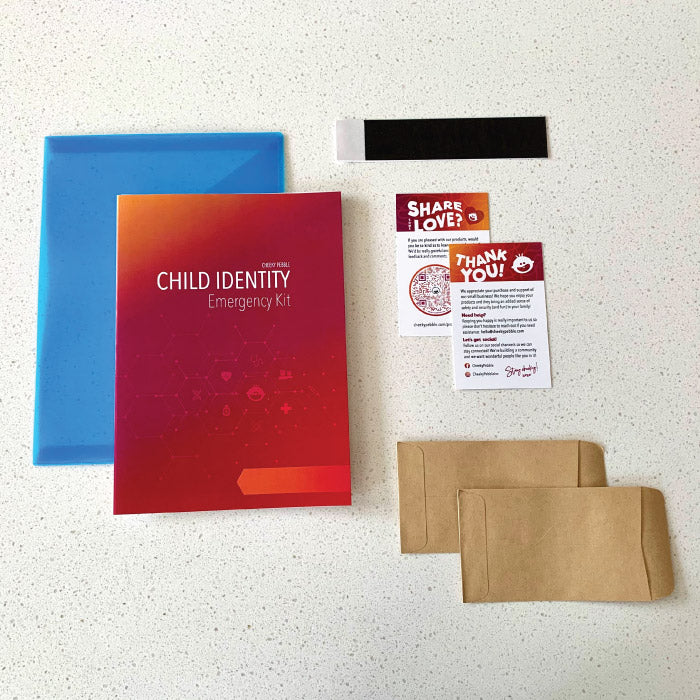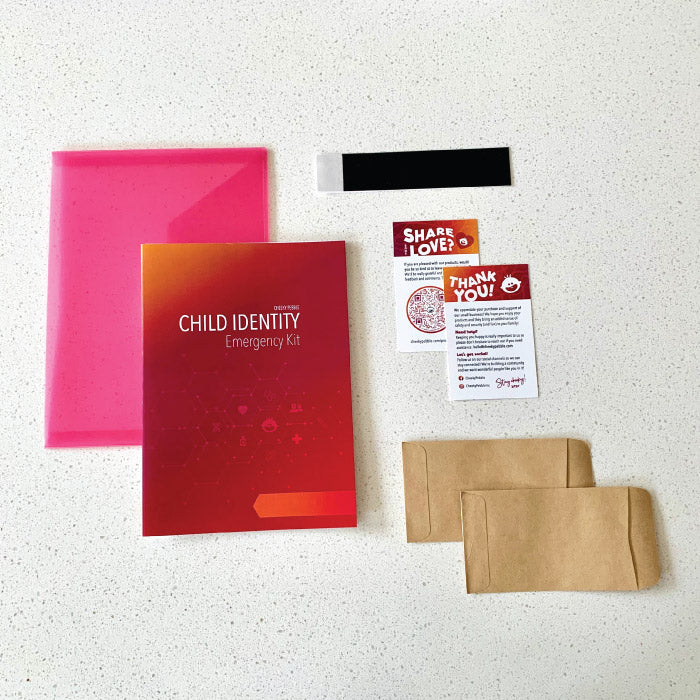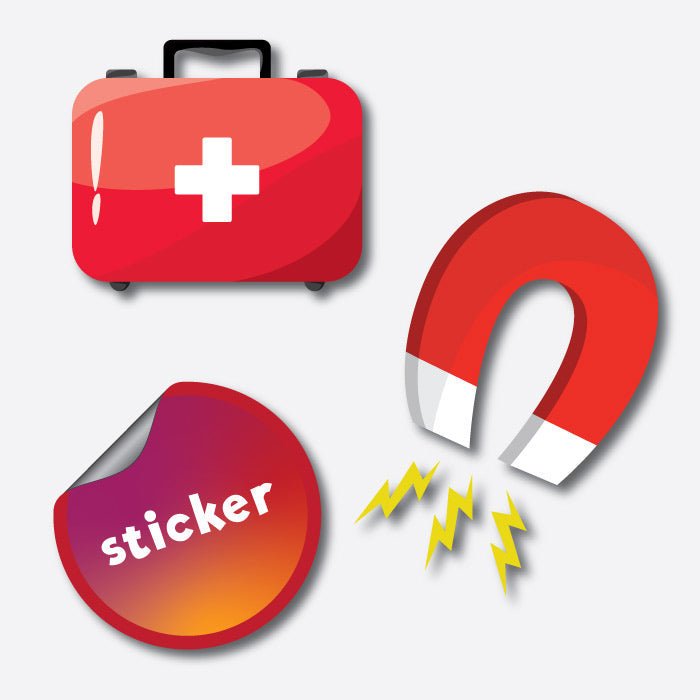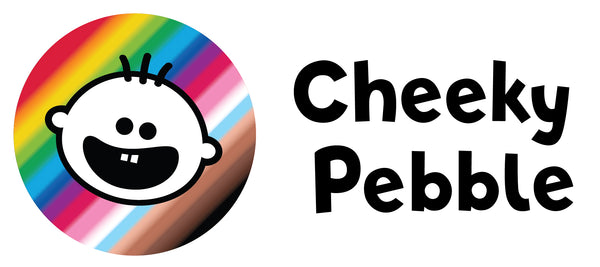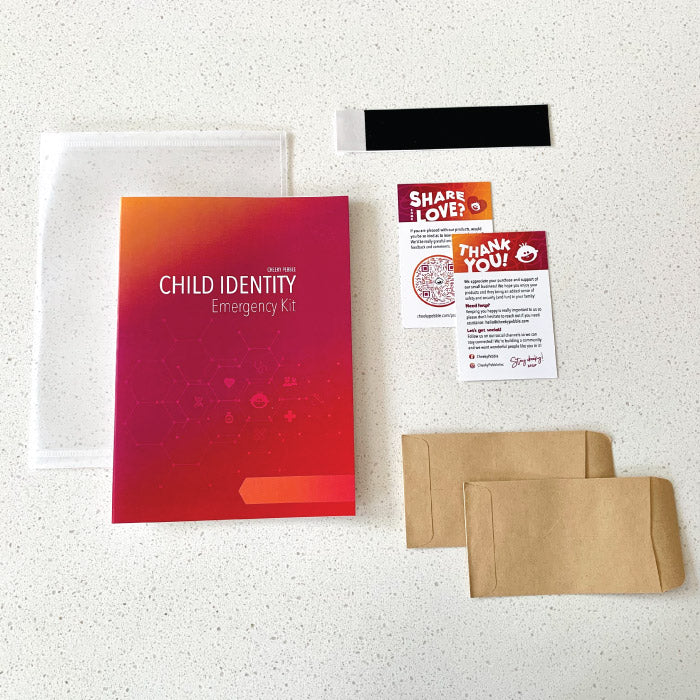Additional Information: Child Identity Emergency Kit
Our Child Identity Kits were designed to help parents be prepared and to effectively aid law enforcement in those crucial first few hours when a child goes missing.
At Cheeky Pebble, our goal is to help keep kids safe in every possible setting when they're out of the home. For those worst-case scenarios, like a child going missing, we wanted to help parents be as prepared as possible. In these unlikely, but terrifying situations where caregivers have absolutely no control, being prepared and ready with detailed information about a child is the best anyone can do. With that in mind, we've created the most comprehensive Child Identity kit available. It contains all the details authorities might need – and parents appreciate having contributed in a very significant way to helping bring their child home.
It is recommended to update these cards every six months to keep the information accurate and beneficial while children are actively growing.
BENEFITS
- Crucial, detailed information is ready and available without delay
- Aids Law Enforcement effectively in those crucial first few hours
- Provides peace-of-mind to parents that they have quickly done what was necessary to help find their missing child
- Good teaching opportunity for children while completing the kit together.
CARD INFORMATION
- Complete this card right away, when you have time to focus and are able to provide accurate and detailed information. Don’t wait for an emergency when you are panicked and not thinking clearly. No one can focus or concentrate during a crisis so don’t add stress to an already terrible situation – complete this card now so you are ready
- PRINT in LARGE, CAPITAL LETTERS so information is legible and easy to read quickly
- Fill out the information card as COMPLETELY AS POSSIBLE. The more information you can provide, the better equipped authorities will be to help your child
- Organ Donor section: this is just for informational purposes only. It is not legally binding and nothing will be done without prior approval.
STORE YOUR ID KIT IN A SAFE, DRY PLACE
- Keep it with other important documents in a location that you would naturally check without thinking
- If there are other significant files regarding your child (special needs notes from specialists, medical information, dental records, etc.) include those as well
- The more information you can provide to authorities, the better equipped they will be to help locate your child
- Scan the ID Kit Card and keep on your phone or on a thumb drive
BODY MAP
It is important to complete this section clearly as it will help identify your child if they are found unresponsive. Indicate any distinguishing characteristics or identifying marks on your child’s body. This includes: birthmarks, moles, scars, medical aids – glasses and hearing aids, prosthetics, previously broken bones, piercings, tattoos, etc.
PHOTO
A candid photo of your child is best as authorities need to know what your child looks like on a normal day. A formal picture is not necessary but your child should be facing forward, not be wearing sun glasses, hats or other accessories, and be the only individual in the picture.
Also ensure your photo is bright and well lit, clear (not blurry) and on a solid, non-distracting background.
FINGER PRINTS
Babies are born with their fingerprints and the pattern will not change throughout their lifetime. Of course scars and skin damage can alter their prints but the pattern they were born with will remain the same. There is no need to wait for them to 'grow into' their prints so you can fingerprint as early as you want. It might be a bit easier when they have a bit more control of their limbs, however, but we will leave the 'when' up to you.
Before starting the Identity Card, try several practice prints elsewhere – especially with the pinky and ring fingers – as they are more difficult to get a good, complete print from. You want to ensure even ink coverage on fingers (not too heavy or faint) in order to capture clean, clear prints once you start the ID card. There is plenty of ink to do both hands as well as lots of trial prints so practice away.
1. Completely wash and dry child’s hands before fingerprinting.
2. Holding clear portion of the strip, peel it apart and place both pieces (ink side up) on a smooth surface.
3. With a light touch, press your child’s finger flat against the ink strip and then flat against the corresponding finger box. Finger should be flat and parallel to the paper. Do NOT roll your child’s finger as this can smudge the fingerprint. Do NOT press firmly as this will smear the print.
4. Repeat for all fingers and thumbs.
5. Wash ink off easily with soap and water.
DNA COLLECTION
Your Child Identity kit should include DNA samples which will further help authorities
- Remember to use sterile gloves and tools (nail clippers, tweezers, brush, etc.) to collect all samples.
- Sterilize nail clippers and tweezers by rubbing with isopropyl alcohol. Spritz or dip your brush in isopropyl alcohol. Allow tools to dry completely.
- Place samples DIRECTLY into provided envelopes. Setting them down first could contaminate them
- Do not lick envelope to close it once collection is completed. Staple or tape envelope closed.
Home collection isn’t as accurate as a lab or forensic kits but they are effective and these are the best three samples to collect:
- Hair with roots/follicle still attached
- Nail clippings (large pieces) from either fingers or toes
- Cheek (buccal) cells
HAIR SAMPLES
Pulled: Hair strands ideally should be pulled so that they include parts of the follicle / root still attached. You can’t use hair that fell off naturally or was cut.
Hairbrush: You can also collect hair from a hairbrush. Use a clean hairbrush (remove all hair first then spritz w alcohol to sanitize) then brush your child’s hair throughly. Remove the hair from the brush (with sterile gloves or tweezers) and place directly into an envelope.
Place DIRECTLY into the envelope – you could contaminate the sample if you touch it, drop it or put it down first.
STAPLE or TAPE the envelope closed. Do not lick the envelope to avoid contaminating the sample.
NAIL CLIPPINGS
Trim your child’s nails like normal but try to clip as large of sample as possible.
Let the clippings fall DIRECTLY into the envelope. Do not handle clippings with your hands, let them drop anywhere or place them down to avoid contamination.
STAPLE or TAPE the envelope closed. Do not lick the envelope to avoid contaminating the sample.
CHEEK (BUCCAL) CELLS
We didn’t include cheek cells on our Child Identity Information Card but feel free to collect these samples if you prefer. They are a bit more time consuming to collect but it isn't difficult, and they are an ideal DNA sample. Just remember you are collecting cheek cells and not saliva.
There are several places on the internet that can provide guidance on how best to do this. Here is a great resource: How to collect a buccal sample
IF YOUR CHILD IS MISSING
- Remain calm and take immediate action
- Attempt to locate the child:
-
Last known location
-
If in a store, notify an employee or the manage and mall security
-
- Home: small hiding places like cupboards, under beds, behind furniture, basements, attics, tool sheds, unlocked vehicles, etc.
- Someone's house: friend, family or neighbours
- Call your local police at 9-1-1 if your child is not located right away
- Be honest with police about the circumstances surrounding your child going missing. It is absolutely critical that the police have a clear picture of the timing and sequence of events leading up to the child's disappearance. This helps them to respond effectively and work towards locating your child.
YOU DO NOT HAVE TO WAIT TO REPORT A MISSING CHILD. In Canada, there is no minimum period of time required to wait before you can report to the police.
SUPPORT & RESOURCES
MissingKids.ca
1 866 KID TIPS (543 8477)
1 800 661 6160
We hope you never have to use these Identity Kits but we are happy to help you be as prepared as possible if your child should ever go missing.
Remember to update these Identity Cards cards every six months while children are actively growing to keep information current and accurate.
Child Identity Emergency Kit
